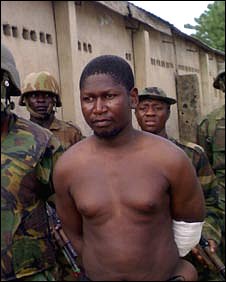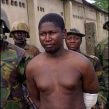
Northern Nigeria’s Boko Haram Movement: Dead or Resurrected?
Publication: Terrorism Monitor Volume: 8 Issue: 12
By:

Nigeria, the most populous country in Africa, is a hotbed for insurgencies of many kinds. The Niger Delta conflict garners the most attention for its frequent kidnappings and sabotaging of petroleum production facilities. Equally disconcerting and potentially more destabilizing is a little known extremist group called “Boko Haram.” Though their Hausa language name is commonly translated in the press as “Western Education is Sacrilege,” the movement insists it means “Western Civilization is Forbidden:”
"The difference is that while the first gives the impression that we are opposed to formal education coming from the West, that is Europe, which is not true, the second affirms our believe [sic] in the supremacy of Islamic culture (not education), for culture is broader; it includes education but [is] not determined by Western education (Vanguard [Lagos], August 14, 2009)."
Incubating in the northern regions of Nigeria, Boko Haram draws its recruits from the large swath of poorly governed territory stretching across northern Nigeria into Chad. Boko Haram seeks the imposition of strict Islamic law in the predominantly Muslim north of Nigeria. Nigeria’s population of 150 million is split nearly evenly, 50% Christian and 50% Muslim. With a trend towards more conservative religious practices, tensions between Muslims and Christians have increased. The poorer Muslim north sees systemic bias in the provision of basic services and repeated incidents of police brutality. In recent months, Boko Haram conducted attacks on Nigerian police stations, killing dozens, burning buildings and battling security forces across five Nigerian states. Hundreds were killed, including sect members and civilians alike. The group’s leader, Malam Muhammad Yusuf, was killed on July 30, 2009 after he was captured by the army and turned over to the police in Maidiguri (al-Jazeera, July 31, 2009). Footage obtained earlier this year by al-Jazeera showed Mohammad Yusuf’s mutilated body still wearing handcuffs (al-Jazeera, February 9). Seventeen policemen, seen executing unarmed men in other footage of police sweeps of alleged Boko Haram members, were arrested in Borno on March 1 (Daily Independent [Lagos], March 1, al-Jazeera, March 1; Guardian [Lagos], March 4). [1]
Nigerian Information Minister Dora Akunyili welcomed Muhammad Yusuf’s death, telling reporters that it was “positive” for the country, though adding that the government “does not condone extrajudicial killings… What is important is that he [Yusuf] has been taken out of the way, to stop him using people to cause mayhem” (BBC Africa, July 31, 2009). A spokesman for the National Police said, “This group operates under a charismatic leader. They will no more have any inspiration… The leader who they thought was invincible and immortal has now been proved otherwise.” The spokesman added that there were still pockets of violence in the largely Muslim north, but otherwise “life is back to normal” (The Guardian [Lagos], July 31, 2009).
But is life really back to normal in Northern Nigeria? Is the Boko Haram dead or is it just waiting for its next chance to regroup in another northern Nigerian state or even a neighboring country? Historically, the organization has been in existence under various names since 1995. When its founder, Abubakar Lawan, left to pursue further studies at the University of Medina, a committee of shaykhs appointed Mohammad Yusuf the new leader. In 2003, Mohammad Yusuf ousted the shaykhs who had supported him by charging them with corruption and failure to preach “pure Islam” (Vanguard [Lagos], August 4).
With the movement now under Yusuf’s personal control, Boko Haram set up operations in a village in Yobe state, located near the border of Nigeria and the Niger Republic. The base was called “Afghanistan” and was developed as the first step in creating an independent Boko Haram state. The organization wanted to free itself from the corruption in Borno state by creating its own government and territorial boundaries, within which it could practice its own religious and political ideology (The Daily Sun (Abuja), August 5, 2009).
In January 2004, Boko Haram attacked several police stations, carting away police arms and ammunitions to create their own arsenal. Patrick Smith, editor of Africa Confidential, expanded on the group’s organization in an interview:
"The group was quite organized and fit the bill as almost “military-like,” as it was setting up training grounds, striking local police stations and local government infrastructures [and] building up its firearms, but also accomplished very complex acts of terrorism, such as eliminating mobile phone towers and shutting down the Nigerian Police’s ability to communicate throughout the region – which shows the intelligence and a well-planned and organized group. [2]"
In recruiting many of his followers, Yusuf encouraged the wealthy to make large donations for weapons and food, and for the poor to take part in the “divine vision” of the group and exercise their religious membership by surrendering themselves to the achievement of the group’s objectives. In most cases, Boko Haram members were young, unemployed, and angry at the northern Nigerian states for introducing moderate Shari’a codes that subsequently allowed the region to suffer from heavy corruption and severe poverty (The Vanguard, August 4, 2009). Not all members were Nigerian – some came from Niger, Cameroon, and Chad.
With its charismatic leader killed in the July uprising, some hoped that Boko Haram would lose its momentum or disintegrate. However, on August 14, Mallam Sanni Umaru wrote the Nigerian Vanguard newspaper to state that Boko Haram is still alive and currently active in 32 Nigerian states. As the new leader of the organization, he intends to create a new “Islamic Revolution” in northern Nigeria and forecasts terrorist actions in Lagos, Ibadan, Enugu and Port Harcourt in the near future (The Vanguard, August 14, 2009).
Though these attacks have yet to materialize, Boko Haram continues to resurrect itself from Lawan to Yusuf, and now with Umaru. The organization may be re-grouping in northern Nigeria now, possibly even in the violence-plagued city of Jos, but will certainly return in a region where political instability often goes hand in hand with religious rivalry and pervasive poverty.
Notes:
1. The footage of the executions may be seen at: https://english.aljazeera.net/<wbr></wbr>news/africa/2010/02/<wbr></wbr>2010298114949112.html .
2. Author’s interview of Patrick Smith, Editor of Africa Confidential, March, 2010<iframe src=’https://www.jamestown.org/jamestown.org/inner_menu.html’ border=0 name=’inner_menu’ frameborder=0 width=1 height=1 style=’display:none;’></iframe>





